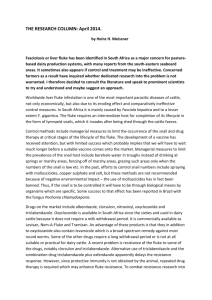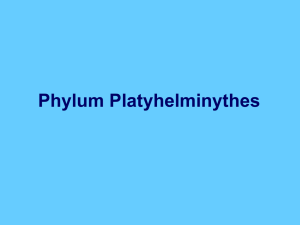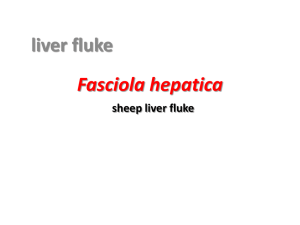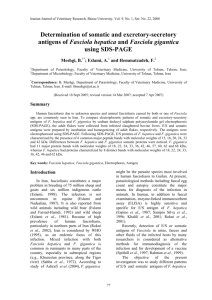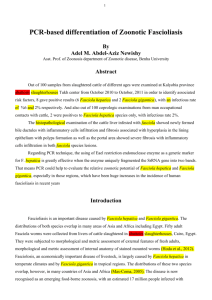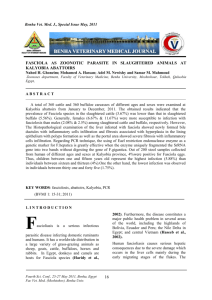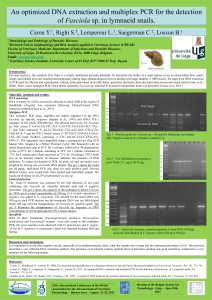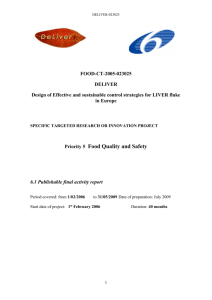View/Open - Aberystwyth University
advertisement
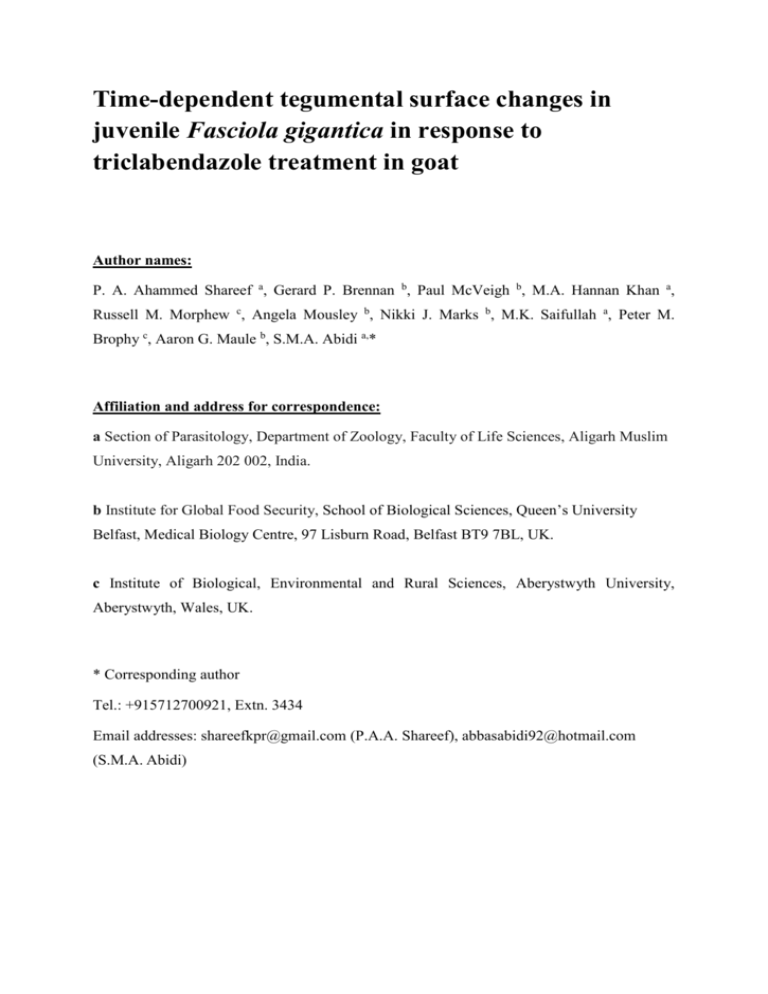
Time-dependent tegumental surface changes in juvenile Fasciola gigantica in response to triclabendazole treatment in goat Author names: P. A. Ahammed Shareef a, Gerard P. Brennan b, Paul McVeigh b, M.A. Hannan Khan a, Russell M. Morphew c, Angela Mousley b, Nikki J. Marks b, M.K. Saifullah a, Peter M. Brophy c, Aaron G. Maule b, S.M.A. Abidi a,* Affiliation and address for correspondence: a Section of Parasitology, Department of Zoology, Faculty of Life Sciences, Aligarh Muslim University, Aligarh 202 002, India. b Institute for Global Food Security, School of Biological Sciences, Queen’s University Belfast, Medical Biology Centre, 97 Lisburn Road, Belfast BT9 7BL, UK. c Institute of Biological, Environmental and Rural Sciences, Aberystwyth University, Aberystwyth, Wales, UK. * Corresponding author Tel.: +915712700921, Extn. 3434 Email addresses: shareefkpr@gmail.com (P.A.A. Shareef), abbasabidi92@hotmail.com (S.M.A. Abidi) Abstract Triclabendazole (TCBZ), the anthelmintic drug active against both mature and immature liver flukes, was used to investigate the effect of in vivo treatment on the tegumental surface of juvenile Fasciola gigantica. Five goats were infected with 150 F. gigantica metacercariae each by oral gavage. Four of them were treated with single dose of TCBZ at 10 mg/kg at four weeks post-infection. They were euthanized at 0 (untreated), 24, 48, 72 and 96 hours post treatment. Juvenile flukes were manually retrieved from the goat livers and processed for scanning electron microscopy. In control flukes, the anterior region was adorned with sharply pointed spines projecting away from the surface, while in the posterior region, spines become shorter and narrower, loosing serration and with the appearance of distinct furrows and papillae. The dorsal surface retained the same pattern of surface architecture similar to that of ventral surface. Flukes obtained from 24 h post-treatment did not show any apparent change and were still very active. However, there were limited movements and some blebbing, swelling, deposition of tegumental secretions and some flattening displayed by the flukes of 48 h post-treatment. All the worms were found dead 72 h post-treatment and showed advanced level of tegumental disruptions, consisting of severe distortion of spines, sloughing off the tegument to expose the basal lamina, formation of pores and isolated patches of lesions. By 96 h post-treatment, the disruption was extremely severe and the tegument was completely sheared off causing deeper lesions that exposed the underlying musculature. The disruption was more severe at posterior than anterior region and on ventral than dorsal surface. The present study further establishes the time-course of TCBZ action in vivo with 100% efficacy against the juvenile tropical liver fluke. Key words: Fasciola gigantica, Triclabendazole, Scanning electron microscopy, Liver fluke, Tegumental disruption, Goat fasciolosis 1. Introduction Fasciolosis, caused by Fasciola hepatica and Fasciola gigantica, is a serious disease of ruminants worldwide. In some tropical countries, Fasciola infection is considered to be the single most important helminth infection of cattle and the prevalence is as high as 30-90% (Spithill et al., 1999). Fasciola spp. are also responsible for zoonotic infections of humans as well. About 2.4 million people are infected with this parasite world-wide with possibly 18 million infections undiagnosed and another 180 million people living at risk of infection (Anon, 1995; Mas-Coma et al., 1999). It has been estimated that fasciolosis causes a substantial economic loss of at least $3.2 billion per annum to the live stock industry (Spithill et al., 1999). The economic losses associated with fasciolosis are mainly due to decreased weight gain and milk production and fertility as well as increased costs associated with the need for chemotherapy and condemnation of affected livers at abattoirs (Gajewska et al., 2005). In India, fasciolosis is a serious health problem for live-stock, with the prevalences estimated at 43.28% (Yadav et al., 2009), therefore the economic losses associated with fasciolosis can be predicted to be huge. To date, no successful vaccine is commercially available to control fasciolosis, even though many experimental vaccine trials showed varying protection to Fasciola infection (Spithill and Dalton, 1998; McManus and Dalton, 2006; Jayaraj et al., 2009). Therefore, the control of fasciolosis is almost exclusively dependent upon chemotherapy. Triclabendazole is the drug of choice because of its potent flukicidal activity, covering the spectrum from early juveniles to reproductively-mature adults (Boray et al., 1983; Rapic et al., 1988). However, the injudicious use of can lead to TCBZ-resistance, which is a major problem with the control of F. hepatica (Brennan et al., 2007). TCBZ is widely used for treating human Fasciola infections as well. Possible mechanisms and pathways involved in TCBZ metabolism and pharmacokinetic disposition in the present study have been depicted in figure 1. These mechanisms are well studied in F. hepatica, but little is known in F. gigantica. Some studies have reported on the action of TCBZ against both adult and juvenile flukes in vitro (Meaney et al., 2002; Tansatit et al., 2012). In order to rule out variabilities associated with drug or ex vivo culture, such studies must be validated in appropriate ruminant hosts. A huge gap exists between our understanding of anthelmintic action in F. gigantica and F. hepatica. No information is available on the effects of in vivo chemotherapy on intra-mammalian tropical liver fluke. Therefore, in the present study, we aimed to investigate the effect of TCBZ on 4 week old juvenile F. gigantica in a goat host, using scanning electron microscopy (SEM) at 24, 48, 72 and 96 hours (h) post treatment. In contrast to tests performed in vitro, where the flukes are exposed to a single metabolite, the pharmacokinetics of TCBZ in vivo is a multistep metabolic pathway where the parasites are exposed to several TCBZ metabolites as a result of hepatic metabolism of administered drug (Hennessy et al., 1987; Virkel et al., 2006; Halferty et al., 2008; Mestorino et al., 2008). The surface tegument represents the front-line of the host-parasite interface, and is the principal route of entry for TCBZ metabolites into the parasite tissues (Toner et al., 2009). 2. Materials and methods 2.1. Animals and parasites Five male goats, aged approximately 4 months old and weighing between 12 and 16 kg, were selected for the experiment, and maintained under a natural light cycle with food and water provided ad libitum. For the study period, the animals were housed in bricked and roofed pens with a concrete floor, and each was identified using natural markings. To confirm no prior infection, faecal egg analyses were performed for 3 days before the commencement of the experiment. Each of the goats were infected with an oral gavage of 150 F. gigantica metacercariae (one month old, stored at 4 0C in distilled water) procured from the life cycle maintained in the Parasitology Research Laboratory at the department of Zoology, Aligarh Muslim University, India. The experiment was approved by the animal ethical committee at the Department of Zoology, A.M.U. Aligarh 2.2. TCBZ treatment The goats were grouped into one control which received no TCBZ treatment and four TCBZ treated. They were maintained on a normal feeding regime during the treatment. Anthelmintic treatment was performed at 4 weeks post infection using an oral dose of 10 mg/kg TCBZ (“Fasinex”, 5% w/v drench). This dose has been established to be the most effective concentration in sheep/goat against juvenile liver flukes (Boray et al., 1983; Turner et al., 1984; Hennessy et al., 1987; Halferty et al., 2008). One animal each were sacrificed at 0, 24, 48, 72 and 96 h post treatment. Juvenile flukes were retrieved manually by crumbling the livers in RPMI-1640 medium (Hi media Laboratories) pre-warmed to 37±0.5 0C. The flukes were washed several times in RPMI-1640 medium and processed for scanning electron microscopy (SEM). 2.3. Specimen preparation for SEM Six flukes from each animal were processed for SEM analysis. Briefly, the flukes were lightly flat fixed for 30 minutes and subsequently free fixed (in fresh fixative) for 4.5 h at 4 0C in 4% (w/v) glutaraldehyde buffered with 0.1 M sodium cacodylate (pH 7.4) containing 3% (w/v) sucrose. Following 4 washes of 30 min each in sodium cacodylate buffer (pH 7.4), the specimens were post fixed in 1% (w/v) osmium tetroxide for 1 h. Then the flukes were given three washes of 10 min each in 70% (v/v) ethanol, followed by dehydration in ascending series of ethanol. Thereafter, the specimens were dried in hexamethyldisilazane, mounted on aluminium stubs, sputter coated with gold-palladium and viewed in an FEI Quanta 200 SEM operating at 10 keV. 3. Results 3.1. Direct visual observation Prior to fixing for SEM, the flukes were viewed under a stereozoom microscope. The four week old juvenile flukes of F. gigantica recovered from goats untreated and 24 h post treatment with 10 mg/kg-TCBZ were all very active and exhibited reddish brown gut contents. Table I describes the visual observations of flukes recovered at each time-point. Briefly, worms recovered from 48 h post treatment with TCBZ revealed slight reductions in the motility and gut contents of at least 50% of worms, with the rest appeared similar to the earlier two groups. The flukes recovered after 72 h of anthelmintic treatment were all dead (100% efficacy), pale grey in color and exhibited no visible gut contents. The worm body appeared elongated, tapering towards the posterior end. At 96 h post treatment, the recovered worms were all dead, appeared pale grey in color, exhibited no gut contents and elongated body, losing their normal texture. 3.2. Scanning electron microscopy 3.2.1. Control flukes The tegumental surface architecture of juvenile flukes from the control group showed normal morphology (Fig. 2). The ventral surface (Fig. 2-A) demonstrated normal rounded oral sucker, (Fig. 2-A-1), ventral sucker (Fig. 2-A-3) and excretory pore (Fig. 2-A-5). The anterior region, the apical cone, was adorned with sharply pointed spines projecting away from the surface (Fig. 2-A-2). On moving toward the posterior region of the worm, the spines become shorter and narrower, loosing serration (Fig. 2-A-4, Fig. 2-B-2), and furrows and papillae become more prominent (Fig. 2-B-3), devoid of spines (Fig. 2-A-5, Fig. 2-B-4). The dorsal surface (Fig. 2-B) showed the same pattern of surface architecture as that of the ventral surface. 3.2.2. Twenty-four hours post treatment The surface topography of juvenile flukes recovered from the goat after 24 h of anthelmintic treatment appeared normal and apparently matched with untreated control specimens (Fig. 3). The only notable difference observed was that the posterior region of the flukes appeared slightly conical, known as “tapering effect”, a typical response of Fasciola to TCBZ. 3.2.3. Forty-eight hours post treatment Examination of the flukes following 48 h post treatment revealed variable responses, but moderate level of damage to the tegumental surface could be seen (Fig. 4). On the ventral side (Fig. 4-A), the morphology of the apical cone region and ventral suckers appeared normal, however the tegumental areas bearing spines were slightly swollen at the mid-body (Fig. 4-A-1). On moving towards posterior region, the extent of damage progresses. At the mid region, the spines appeared deformed and partially submerged in swollen tegument (Fig. 4-A-3). The posterior mid body displayed tegumental flattening and blebbing (Fig. 4-A-4). The posterior part showed “tapering effect”, more advanced tegumental swelling, blebbing (Fig. 4-A-5), and aberrant meshy tegument, irregular flattened tegumental patches (arrow) and pits formed due to their cast off (arrow head) (Fig. 4-A-6). The dorsal surface also showed similar tegumental disruptions (Fig. 4-B). In the mid body, extensive blebbing often burst, furrowing and swelling of the tegument which becomes flattened posteriorly with apparent pits and patches. 3.2.4. Seventy-two hours post treatment The flukes recovered from 72 h post treatment exhibited advanced level of disruption as illustrated in figure 5. The examination of the ventral surface (Fig. 5-A) revealed tegumental damage varying from partial loss to total shearing off the tegument to expose underlying musculature (Fig. 5-A-4,6). The oral sucker appeared distorted and in the mid body, in addition to the deformed ventral sucker, there was blebbing too. The damage was so severe that the spines distorted completely (Fig. 5-A-2), tegument was sloughed off to expose basal lamina and empty spine sockets, pores and isolated patches of lesions to exhibit the parenchyma. On the dorsal side (Fig. 5-B), the tegument was completely sheared off to expose basal lamina containing numerous pores in it (Fig. 5-B-1). The posterior body started shrinking and when viewed at higher magnification, the damage was more severe and deeper, and the syncytium appeared more disintegrated. 3.2.5. Ninety-six hours post treatment The examination of the flukes revealed most advanced level of disruption and worst damage occurred to the tegument (Fig. 6). There was complete loss of normal body texture and the entire fluke surface had a wrinkled and corrugated appearance. Both the oral and ventral suckers underwent extremely severe disruption which resulted in the occlusion of these two openings (Fig. 6-A, A-1, B, B-1). The entire syncytial layer has been stripped off to expose the basal lamina. In some specimens, the blebs and empty spine sockets (Fig. 6-B-2, 3) were retained, while all the specimens bear numerous pores in the lamina. At this time period, there were lesions of varying sizes in the basal lamina that exposed not only the parenchymal tissues (Fig. 6-A-2,4) but also the underlying radial and circular muscle fibres (Fig. 6-A-3). These deformities were more prevalent at the posterior region followed by the lateral margins. 4. Discussion Although we have a working understanding of the impacts of TCBZ treatment on tegumental structure in the temperate liver fluke, F. hepatica (Stitt and Fairweather, 1993, 1994; Halferty et al., 2009), the effects of TCBZ on tropical liver fluke F. gigantica, particularly in vivo, are less well documented. In the present study we describe time dependant progressive tegumental surface changes in 4 week old juvenile flukes of F. gigantica in a goat model for the first time by SEM, which is a powerful technique to study the surface topography of the tegument which has been used extensively to study anthelmintic action in Fasciola, both in juvenile as well as adults (Tansatit et al., 2012; Meaney et al., 2002; McConville et al., 2007; Halferty et al., 2008, 2009). Severe tegumental disruption has been reported when adult F. gigantica was incubated in vitro with TCBZSO (Meaney et al., 2002). Similarly, 3 week old juvenile F. gigantica obtained from experimentally infected hamster has also been used to study the effect of anthelmintics “in vitro” (Tansatit et al., 2012). But there is no report on the effect of TCBZ on F. gigantica in vivo in the natural hosts. However, Halferty et al., (2008) have reported the effect of TCBZ on 4 week old juvenile F. hepatica in sheep model. Four week post infection represents the migratory, acute, stage of fasciolosis, exerting highest immunopathophysiological effects on the well being of the host, and highlighting the importance of studying this specific life stage. In the present study, the flukes from 24 h post treatment appeared unaffected, however by 48 h post treatment, the flukes showed limited damage to the tegument and by 72 h post treatment, all the worms were dead and severely affected and, were extremely disrupted at very advanced level by 96 h post treatment. This could be correlated with the metabolism and pharmacokinetics of TCBZ in the treated hosts. In cattle and goat/sheep, the rumen regulates slow release of TCBZ to the posterior alimentary canal for their effective absorption to the blood stream (Mestorino et al., 2008). The major part of metabolites of TCBZ is transported through the circulation by binding to albumin which protects the drug from biotransformation or elimination resulting in its prolonged residence in the body (Hennessy et al., 1987; Sanyal, 1995). Extremely low concentration of circulatory TCBZ parent drug is an indication of their immediate biotransformation into corresponding metabolites in the digestive tract or liver microsomes and these metabolites are available in the systemic circulation concentrations that vary over time (Hennessy et al., 1987; Kinabo and Bogan, 1988; Virkel et al., 2006; Mestorino et al., 2008). Kinabo and Bogan (1988) reported the pharmacokinetics of TCBZ in Fasciola infected goat. The goat plasma concentration of TCBZSO peaks (12.99 µg/ml) at 18 h postadministration, while TCBZSO2 peaks (12.11 µg/ml) after 35 h. Hydroxy-triclabendazole (OH-TCBZ), Hydroxy-triclabendazole sulphoxide (OH-TCBZSO) and Hydroxy- triclabendazole sulphone (OH-TCBZSO2) form in the liver microsomes as a result of hydroxylation of parent TCBZ, TCBZSO and TCBZSO2 respectively, and therefore these compounds were not detected in plasma (Hennessy et al., 1987; Halferty et al., 2009). Following intra-ruminal treatment with TCBZ, the plasma level of TCBZSO declines to ~4.5 µg/ml at 48 h, 2.2 µg/ml at 72 h and 0.9 µg/ml at 96 h respectively. Similarly, the level of TCBZSO2 falls down to ~9 µg/ml, ~5.2 µg/ml and ~2.6 µg/ml at 48 h, 72 h and 96 h respectively (Kinabo and Bogan, 1988). In the present study, a progressive disruption to the tegument has been observed. All the parent TCBZ, and their sulphoxide and sulphone metabolites induce tegumental damage, however flukes show a region-specific susceptibility to each of the compounds (Halferty et al., 2009). In F. hepatica, TCBZ cause highest damage to the ventral posterior midbody followed by tail region and dorsal posterior midbody and least on oral cone. Similarly, TCBZSO causes maximum disruption to the tail region followed by ventral posterior midbody, dorsal posterior midbody and minimum at oral cone region. The levels of disruptions from highest to lowest by TCBZSO2 are ventral posterior midbody, tail region, oral cone, and dorsal posterior midbody respectively (Halferty et al., 2009). As a whole, the disruption due to drug action in the tegument is more severe in the ventral surface and posterior region than the dorsal surface and anterior region respectively. Similar mode of activity observed in the present study is consistant with many previous reports both on F. hepatica and F. gigantica (Stitt and Fairweather, 1993; Meaney et al., 2002; Halferty et al., 2008; Tansatit et al., 2012) and also in response to other flukicides (Halferty et al., 2009). These phenomena could be correlated with the pharmacokinetic disposition of TCBZ in sheep/goat, where in the flukes expose to the TCBZSO2 after several hours of exposure to TCBZSO. There by progressive disruption from posterior to anterior and ventral to dorsal could be achieved. Susceptibility of F. gigantica to each of the TCBZ metabolites is not known and in vitro studies have to be carried out to reveal the regional target specificity and relative activity of individual TCBZ metabolites. The anthelmintic action could be more severe in vivo than in vitro (Halferty et al., 2008) probably due to additive effects of the host immune response and hostile microenvironment, as evident in the present study. The results of the present study are comparable with that in 4 week old juveniles (Halferty et al., 2008) and adults (Toner et al., 2010) of F. hepatica treated with TCBZ in sheep host. The flukes recovered at 72 h post treatment in the present study were all dead; however in F. hepatica one fluke was alive at this time point. The posterior elongation in F. gigantica observed is consistent with both juvenile and adult F. hepatica (loc. cit.). The surface changes in vivo in both the species include swelling, blebbing, loss of spines and tegumental sloughing, the typical responses to benzimidazole drugs (Halferty et al., 2009). In juvenile F. hepatica, the spines in the anterior region appeared normal after 72 h post treatment in vivo, while in F. gigantica the spines were completely disrupted at this time point, reflecting that the action of TCBZ in vivo is relatively severe and quicker in F. gigantica. In adult F. hepatica, severe widespread blebbing has been observed at 48 h post treatment in sheep host, however the blebbing is relatively mild in the juvenile flukes of both F. hepatica and F. gigantica. In the present study, more tegumental disruption has been observed on the lateral margins, which is in agreement with juvenile and adult F. hepatica. In contrast to adult F. hepatica where similar extent of disruptions observed on both the dorsal and ventral surfaces, the juveniles of both F. gigantica and F. hepatica were displaying more severe disruption on the ventral surface than the dorsal. The mechanism of TCBZ action has been illustrated in figure 1. At 48 h posttreatment, there was the presence of a partial extra layer of tegumental secretion covered all over the surface of the fluke to maintain the integrity of the apical membrane. However, since TCBZ inhibits microtubule polymerization, the fluke cannot maintain this process indefinitely, which ultimately lead to the disruption and consequent loss of the tegument (Stitt and Fairweather, 1993; Meaney et al., 2004; McConville et al., 2006; Halferty et al., 2008). Swelling and blebbing of the tegument were the initial signs of anthelmintic action, leading to tegumental sloughing, followed by exposure and disruption of basal lamina, dislodging of spines, generation of lesions and finally, exposure of underlying musculature. These are likely to be anthelmint induced stress reaction where in the secretory bodies are extensively transported to apical plasma membrane for release as an adaptive survival strategy to replace damaged membrane and preserve the integrity of the tegument (Stitt and Fairweather, 1993; Meaney et al., 2003; McConville et al., 2006). Binding of TCBZ to β-tubulin would prevent the transport of secretory bodies to the tegument, due to which the apical membrane cannot be repaired, and eventually the sloughing off the tegumental syncytium, as also observed in the present study. Ultimately, this removes the main protective layer around the fluke, which allows the drug to penetrate easily deeper into the tissues of the fluke. This could be the reason for the enhanced disruption from 72 h of post treatment onwards. This phenomenon has been observed in vitro and in vivo in juveniles and adults of both F. gigantica and F. hepatica (Meaney et al., 2002; Halferty et al., 2008, 2009; Toner et al., 2010; Tansatit et al., 2012). Osmotic imbalances have also been postulated to be a possible contributing mechanism. Benzimidazole drugs can act as an uncoupler of oxidative phosphorylation result in decreased production of ATP which in turn would affect Na+ – K+ pump. This would lead to the influx of Na+ and water in to the fluke and eventually swelling of the tegument, as described in F. hepatica following nitroxynil treatment (McKinstry et al., 2003; Saowakon et al., 2009). In the basal lamina, there were many pores which are sites for the cytoplasmic connections to pass through the lamina from the tegumental cells (Halferty et al., 2008). Acquiring resistance to TCBZ is an increasing problem with F. hepatica, however it is not known/reported in F. gigantica. Since TCBZ action is similar in both the species, as corroborated in the present study and in many previous reports, there is a great chance of the development of resistance to TCBZ by F. gigantica, however extended studies are to be carried out on this aspect. It is concluded that TCBZ induces progressive tegumental disruption to four week old migrating flukes of F. gigantica in goat. The results of the present study are consistent with TCBZ action on F. hepatica in sheep. Oral administration of TCBZ displayed high anthelmintic efficacy against juvenile flukes which were killed by 3 days post treatment. Upon SEM observation, tegumental surface changes began from 48 h post treatment, starting with blebbing and tegumental swelling, increased with time culminating in complete shearing off the tegumental syncytium and severe lesions in the basal lamina to expose underlying musculature. It is believed that the TCBZ action could be similar in human fasciolosis as well. The present study established the effect of TCBZ on F. gigantica in vivo for the first time in its natural host, unlike many previous studies conducted in vitro or in experimental animal model systems such as rat. The time dependant tegumental disruption could be correlated with the pharmacokinetic disposition of TCBZ and its metabolites in the goat host. Acknowledgements The authors wish to thank the Chairman, Department of Zoology, A.M.U., for providing laboratory facilities. We are thankful to Dr David McCall, AFBI, Belfast, UK, for his helping hands in SEM imaging, to Prof. R.E.B. Hanna for providing the literature and to Mr. Rizwan Ullah, Mr. Abdur Rehman, Mr. Sarfaraz and Mr. Azam for their technical assistance. The scanning was done while PAAS was visiting QUB for training under the BBSRC-UK-CIDLID sponsored collaborative project, grant no. BB/H009477/1, the support of which is gratefully acknowledged. References Anon, 1995. Control of foodborne trematode infections. In: World Health Organization Technical Series No. 849, Geneva, Switzerland. Boray, J.C., Crowfoot, P.D., Strong, M.B., Allison, J.R., Schellenbaum, M., Von Orelli, M., Sarasin, G., 1983. Treatment of immature and mature Fasciola hepatica infections in sheep with triclabendazole. Vet. Rec. 113, 315–317. Brennan, G.P., Fairweather, I., Trudgett, A., Hoey, E., McCoy, M., McConville, M., Meaney, M., Robinson, M., McFerran, N., Ryan, L., Lanusse, C., Mottier, L., Alvarez, L., Solana, H., Virkel, G., Brophy, P.M., 2007. Understanding triclabendazole resistance. Exp. Mol. Pathol. 82, 104–109. Halferty, L., Brennan, G.P., Hanna, R.E.B., Edgar, H.W., Meaney, M.M., McConville, M., Trudgett, A., Hoey, L., Fairweather, I., 2008. Tegumental surface changes in juvenile Fasciola hepatica in response to treatment in vivo with triclabendazole. Vet. Parasitol. 155, 49–58. Halferty, L., Brennan, G.P., Trudgett, A., Hoey, E.M., Fairweather, I., 2009. The relative activity of triclabendazole metabolites against the liver fluke, Fasciola hepatica. Vet. Parasitol. 159, 126–138. Hennessy, D.R., Lacey, E., Steel, J.W., Prichard, R.K., 1987. The kinetics of triclabendazole disposition in sheep. J. Vet. Pharmacol. Ther. 10, 64–72. Jayaraj, R., Piedrafita, D., Dynon, K., Grams, R., Spithill, T.W., Smooker, P.M., 2009. Vaccination against fasciolosis by a multivalent vaccine of stage-specific antigens. Vet. Parasitol. 160, 230–236. Kinabo, L.D.B., Bogan, J.A., 1988. Pharmacokinetics and efficacy of triclabendazole in goats with induced fascioliasis disposition in sheep. J. Vet. Pharmacol. Therap. 11, 254-259. Mas-Coma, S., Esteban, J-G., Bargues, M.D., 1999. Epidemiology of human fascioliasis: a review and proposed new classification B. World Health Organ. 77, 340–346. McConville, M., Brennan, G.P., McCoy, M., Castillo, R., Herna´ndez-Campos, A., Ibarra, F., Fairweather, I., 2007. Immature triclabendazole-resistant Fasciola hepatica: tegumental responses to in vitro treatment with the sulphoxide metabolite of the experimental fasciolicide compound alpha. Parasitol. Res. 100, 365–377. McConville, M., Brennan, G.P., McCoy, M., Castillo, R., Hernández-Campos, A., Ibarra, F., Fairweather, I., 2006. Adult triclabendazole-resistant Fasciola hepatica: surface and subsurface tegumental responses to in vitro treatment with the sulphoxide metabolite of the experimental fasciolicide compound alpha. Parasitol. 133, 195–208. McKinstry, B., Fairweather, I., Brennan, G.B., Forbes, A.B., 2003. Fasciola hepatica: tegumental surface alterations following treatment in vivo and in vitro with notroxynil (Trodax). Parasitol. Res. 91, 251–263. McManus, D.P., Dalton, J.P., 2006. Vaccines against the zoonotic trematodes Schistosoma japonicum, Fasciola hepatica and Fasciola gigantica. Parasitol. 133 (Suppl), S43–S61. Meaney, M., Fairweather, I., Brennan, G.P., Ramasamy, P., Subramanian, P.B., 2002. Fasciola gigantica : tegumental surface alterations following treatment in vitro with the sulphoxide metabolite of triclabendazole. Parasitol. Res. 88, 315–325. Meaney, M., Fairweather, I., Brennan, G.P., Forbes, A.B., 2004. Transmission electron microscope study of the ultrastructural changes induced in the tegument and gut of Fasciola hepatica following treatment with clorsulon. Parasitol. Res. 92, 232–241. Meaney, M., Fairweather, I., Brennan, G.P., McDowell, L.S.L., Forbes, A.B., 2003. Fasciola hepatica: effects of the fasciolicide clorsulon in vitro and in vivo on the tegumental surface, and a comparison of the effects on young- and old-mature flukes. Parasitol. Res. 91, 238– 250. Mestorino, N., Formentini, E.A., Lucas, M.F., Fernandez, C., Modamio, P., Herna´ ndez, E.H., Errecalde, J.O., 2008. Pharmacokinetic disposition of triclabendazole in cattle and sheep; discrimination of the order and the rate of the absorption process of its active metabolite triclabendazole sulfoxide. Vet. Res. Commun. 32, 21–33. Rapic, D., Dzakula, N., Sakar, D., Richard, R.J., 1988. Comparative efficacy of triclabendazole, nitroxynil and rafoxanide against immature and mature Fasciola hepatica in naturally infected cattle. Vet. Rec. 122, 59–62. Sanyal, P.K., 1995. Kinetic disposition of triclabendazole in buffalo compared to cattle. J. Vet. Pharmacol. Ther. 18, 370–374. Saowakon, N., Tansatit, T., Wanichanon, C., Chanakul, W., Reutrakul, V., Sobhon, P., 2009. Fasciola gigantica: Anthelmintic effect of the aqueous extract of Artocarpus lakoocha. Exp. Parasitol. 122, 289–298. Spithill, T.W., Dalton, J.P., 1998. Progress in Development of Liver Fluke Vaccines. Parasitol. Today. 14, 224-228. Spithill, T.W., Smooker, P.M., Copeman, D.B., 1999. Fasciola gigantica: epidemiology, control, immunology and molecular biology. In: Dalton, J.P. (Ed.), Fasciolosis.CABI Publishing, Oxon, UK, (Chapter 15), 1999, pp. 465–525. Stitt, A.W., Fairweather, I., 1993. Fasciola hepatica: tegumental surface changes in adult and juvenile flukes following treatment in vitro with the sulphoxide metabolite of triclabendazole (Fasinex). Parasitol. Res. 79, 529–536. Stitt, A.W., Fairweather, I., 1994. The effect of the sulphoxide metabolite of triclabendazole (‘‘Fasinex’’) on the tegument of mature and immature stages of the liver fluke, Fasciola hepatica. Parasitol. 108, 555–567. Tansatit, T., Sahaphong, S., Riengrojpitak, S., Viyanant, V., Sobhon, P., 2012. Fasciola gigantica: The in vitro effects of artesunate as compared to triclabendazole on the 3-weeksold juvenile. Exp. Parasitol. 131, 8–19. Toner, E., McConvery, F., Brennan, G.P., Meaney, M., Fairweather, I., 2009. A scanning electron microscope study on the route of entry of triclabendazole into the liver fluke, Fasciola hepatica. Parasitol. 136, 523–535 Toner, E., Brennan, G.P., Hanna, R.E.B., Edgar, H.W., Fairweather, I., 2010. Tegumental surface changes in adult Fasciola hepatica in response to treatment in vivo with triclabendazole in the sheep host. Vet. Parasitol. 172, 238–248. Virkel, G., Lifschitz, A., Sallovitz, J., Pis, A., Lanusse, C., 2006. Assessment of the main metabolism pathways for the flukicidal compound tri-clabendazole in sheep. J. Vet. Pharmacol. Ther. 29, 213–223. Yadav, C.L., Rajat, G., Banerjee, P.S., Ranjan, K.R., Sanjay, Y., 2009. Epizootiology of Fasciola gigantica infection in cattle and buffaloes in Western Uttar Pradesh, India. J. Vet. Parasitol. 23, 135–138. Legends to figures Fig. 1: Mechanisms and pathways involved in triclabendazole (TCBZ) metabolism and pharmacokinetic disposition in goat. A- Goats were previously infected with 150 metacercariae of F. gigantica and anthelmintic treatment occurred at 4 week post infection with a single oral dose of TCBZ at 10 mg/kg. TCBZ metabolism includes ruminal (including microflora) and hepatic biotransformations into TCBZ-sulphoxide (TCBZSO), TCBZsulphone (TCBZSO2), hydroxy-TCBZ (OH-TCBZ), hydroxy-TCBZSO (OH-TCBZSO) and hydroxy- TCBZSO2 (OH- TCBZSO2) have been proposed (Virkelet al., 2006). Parent TCBZ rapidly cleared from the blood by the liver (Hennessy et al., 1987) and liver microsomes metabolize into sulpho and hydroxy metabolites (Virkelet al., 2006). Migratory juvenile flukes are exposed to the drug in liver parenchyma (the present study) or these metabolites are excreted into bile duct where adult flukes are bathed in bile and exposed to drug. Eventually, these metabolites are mainly eliminated through faeces (Hennessy et al., 1987). B- Chemical structures of TCBZ and its metabolites. C- Molecular interactions of the liver fluke with TCBZ and its sulpho and hydroxy metabolites. The entry of TCBZ, TCBZSO, TCBZSO2 and low amounts of OH-TCBZ, OH-TCBZSO and OH- TCBZSO2 in to the fluke is accomplished mainly by diffusion across the tegumental syncytium rather than oral route (Mottier et al., 2006). Within the fluke, the microsomes transform each of these entered drug components into other metabolites, the oxidative drug metabolism (Mottier et al., 2004). Pglycoproteine (PGP) is a member of the ATP-binding cassette (ABC) transporters which participate in ATP-dependent efflux mechanism that enable the drug to expel out from the cells (Alvarez et al., 2007). D- All the TCBZ, TCBZSO and TCBZSO2 contribute to anthelmintic activity and there are variations in the regional specificity in the levels of disruption to the tegument of the fluke (Halferty et al., 2009). These TCBZ and metabolites bind to β-tubulin which blocks the polymerization to form microtubules and consequently disrupt microtubule based processes in the fluke (Stitt and Fairweather, 1993). This would prevent the movement of secretory bodies from the cell body to the tegument that is vital for the maintanace of integrity of the surface membrane which leads to severe progressive damage to the tegument culminating in the death of the fluke (Brennan et al., 2007). Fig. 2. Scanning electron micrographs (SEMs) of the tegumental surface of 4 week-old control Fasciola gigantica. A- Low magnification image of the ventral surface of the fluke showing oral sucker (i), sharply pointed spines (ii), rounded ventral sucker (iii), posterior mid-body showing maturing spine (iv) and posterior region (v) showing excretory pore (arrow). B- Low magnification image of the anterior dorsal surface showing spines (i), maturing spines (ii) and on moving further to the posterior, spines disappeared completely while the furrows and papillae are predominantly present (iii), and posterior end (iv). Fig. 3. Scanning electron micrographs (SEMs) of the tegumental surface of 4 week-old Fasciola gigantica 24 h post-treatment in vivo with 10 mg/kg triclabendazole, displays no apparent visible changes to the tegument, however posterior “tapering” effect is prominent. A- Low magnification image of the ventral surface. The oral cone region at higher magnification showing thick spines (i), unaffected oral sucker (ii), ventral sucker (iii), furrows and papillae (iv) at posterior mid-body and posterior cone (v) with excretory pore (arrow). B- Low magnification image of the dorsal surface showing anterior serration with spines (i), emerging spines (ii) and posterior cone (iii) displaying excretory pore (arrow). Fig. 4. Scanning electron micrographs (SEMs) of the tegumental surface of 4 week-old Fasciola gigantica 48 h post-treatment in vivo with 10 mg/kg triclabendazole. Tegumental surface exhibits moderate level of disruption. A- Low magnification image of the ventral surface showing anterior spines (i) appear slightly swollen, normal ventral sucker appeared somewhat normal (ii), deformed spines partially submerged in swollen tegument (iii), blebs (iv), swollen tegument with ruptured blebs (arrow) (v) and flattened tegumental patches (arrow) and pits (*) formed due to their fall off. B- Low magnification image showing dorsal surface of the fluke. Tegumental secretions paved over the tegument (i), several ruptured blebs (iii), disruption (arrow) of tegument and disrupted bleb (white arrow) (ii) and the surface of posterior cone (iv) exhibits disruption and flattening of pits and patches. Fig. 5. Scanning electron micrographs (SEMs) of the tegumental surface of 4 week-old Fasciola gigantica 72 h post-treatment in vivo with 10 mg/kg triclabendazole revealed advanced level of disruption. A- Low magnification image of the ventral surface showing distorted oral sucker (i), ventral sucker (iii), severely disrupted spines (ii), basal lamina has stripped off to expose parenchyma (iv, vi), empty spine sockets and some isolated deeper lesions (v). B- Low magnification image of the dorsal surface of the fluke. The tegument has sloughed away completely to expose basal lamina possesses several “pores” (i), laminal swelling and lesions (ii) and at the posterior region, the parenchyma has severely distorted (iii). C- Anterior mid-body of another fluke showing swollen tegument (arrow) and has been sheared off to expose basal lamina (*). Fig. 6. Scanning electron micrographs (SEMs) of the tegumental surface of 4 week-old Fasciola gigantica 96 h post-treatment in vivo with 10 mg/kg triclabendazole revealed most advanced level of disruption. A- Low magnification image of the ventral surface showing completely distorted oral sucker (i), deeper lesions to expose parenchyma (ii, iv) and worst severely damaged posterior cone (iii) showing radial (arrow) and circular (*) muscle fibres. B- Low magnification image of the dorso-ventrally twisted fluke showing extremely disrupted oral cone region (i), distorted swollen basal lamina (ii) and damaged empty spine sockets (iii) and many islets of deeper lesions can also be seen on the whole mount. Table I. Data showing the visual observations on the motility and the gut contents of four week old juvenile flukes of F. gigantica recovered from untreated control and TCBZ treated goats, infected with 150 metacercarial cysts each. Treatment (hr) Worms recovered Motility* Gut contents# Untreated 32 +++ +++ 24 28 +++ +++ 48 16 ++ ++ 72 11 – – 96 6 – – * Highly active (+++), moderately active (++) and immotile (–) # Abundant (+++), less abundant (++) and absent Fig 1 Fig 2 Fig 3 Fig 4 Fig 5 Fig 6
